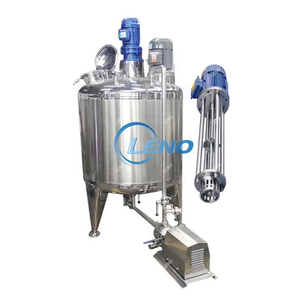
All categories
Featured selections
Trade Assurance
Buyer Central
Help Center
Get the app
Become a supplier

(733 products available)



























High shear viscous liquid dispersers are specialized mixing equipment designed to process and mix liquids with high viscosity. Numerous high-shear mixers are available in the market to cater to different industries and viscosity levels. Here are some popular types.
Product characteristics
-Hammer - an Industrial mixer with a hight-speed motor creates a powerful impact that can break up solids and get them dispersed into the liquid matrix. High shear hammers are ideal for processing highly viscous liquids that contain large solids or a high percentage of dry matter. They are usually used in foods (mayonnaise, dressings, juices, ketchup, sauces, and others), chemical (adhesives, waterproofing, rust removers, foam agents, multi-surface cleaners, and others), and pharmaceutical (liquid medicines, syrups, solutions, and others) industries.
Product characteristics
-Inline - An In-line/inline industrial high shear mixer usually comes with a separate motor and gearbox to ensure the right speed and torque for the application. Inline mixers are ideal for large volumes of product or continuous process applications. Generally, they are plumbed into existing product lines and run with the product continuously.
Product characteristics
-Batch - A batch high shear mixer processes discrete quantities of viscous liquid and may also be known as a batch mixer or kettle mixer. It immixes of the specific volumes at a time. The advantages are that it usually occupies less floor space compared to inline models. They also tend to process more viscous liquids than inline models.
Product characteristics
-Pumping - A pumping high shear mixer has a unique design that allows it to create high shear forces while moving material through a pumping action.
The following are some common specifications, along with their maintenance tips and requirements:
High shear disperser emulsifiers are crucial for numerous industries where the need to break down, mix, and develop stable products is essential. Here are some industries where these machines are commonly used:
The following tips may help when searching for an ideal high shear mixer for an industrial application:
Understand Product Characteristics and Processing Needs
Know the specific physical and chemical attributes of the product to be mixed, such as its density, viscosity, temperature, volume, etc. Also, determine the desired processing result, like particle size reduction, emulsification, homogenization, etc. And consider the required processing capacity and time.
Review Machine Performance
Choose the high shear mixer that can handle the materials' viscosity and the machine's maximum permissible viscosity. Check the shear forces generated by the equipment, as a higher shear generally results in a finer and more uniform product. Consider the capacity of the machine and its processing speed. Calculate how many units would be necessary for the intended application. Examine the energy efficiency of the mixer, as this can significantly impact operational costs.
Consider Construction Quality
Ensure the device is built with high-quality materials to ensure durability. Check if the construction is solid enough to resist frequent, prolonged use. Choose an apparatus with a simple design for adequate, rapid cleaning and maintenance. Select an appropriate machine for the intended installation type, such as a stand-alone, wall-mounted, or integrated unit.
Check Safety Features
Verify that the chosen mixer has the necessary safety features, such as overload protection, emergency stop buttons, etc., and ensure that it complies with safety standards and regulations. Consider the need for any additional safety measures, such as equipment guarding or safety interlocks.
Q1 What is the difference between a low shear and a high shear mixer?
A1 Low-shear mixers can usually handle large batches. They are used for gentle mixing and mainly to create homogeneous products without gas escaping. Low-shear mixers are also belt-driven rather than motor-driven. On the other hand, high shear mixers break down particles using high energy and speed. They disperse the product well and create emulsions.
Q2 Can a high shear mixer emulsify?
A2 Yes, a high shear mixer can emulsify products. An emulsion is a mix of two or more liquids that normally do not combine, like oil and water. High shear mixers create stable emulsions thanks on the intensity of the mixing process.
Q3 Can a high shear mixer make foam?
_A3_ Yes, high shear mixers can make foams. The process of mixing at high speed introduces air into the product. Surfactants, fox example, can create stable foams.
Q4 What are the benefits of a high shear mixer?
A4 The high shear mixer is versatile and can do many things, like homogenizing, emulsifying, dispersing, and breaking down solid particles. It is an efficient and time-saving piece of equipment. The mixer can handle different viscosities from low to high. It is simple to operate and clean.